
Roberts S.M., Poignant G. - Catalysts for fine chemical synthesis (Vol.1) (2002)(en)
.pdf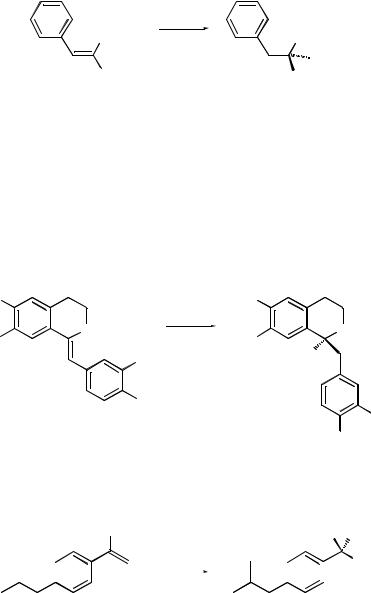
the integration of biotransformations into catalyst |
15 |
||
|
i |
|
|
NHCOPh |
NHCOPh |
|
|
|
H |
|
|
CO2H |
CO |
H |
|
|
2 |
|
|
96% ee
Scheme 12: Reagents and conditions: i) [(BINAP)Rh(MeOH)2 ]‡[ClO4 ]ÿ cat., 1 atm H2 , MeOH.
The broad range of alkenes undergoing asymmetric hydrogenation using ruthenium-based systems as catalysts has attracted the attention of chemists engaged in the synthesis of chiral biologically active natural products (Scheme 13)[60] and other pharmaceuticals (Scheme 14)[61]. a, b-Unsaturated phosphoric acids and esters have also proved to be suitable substrates for Ru(II)-catalysed asymmetric hydrogenation*[62].
MeO |
|
MeO |
|
|
i |
NCOMe |
|
NCOMe |
MeO |
|
MeO |
|
OMe |
H |
|
|
OMe
OMe
OMe
99.5 % ee
Scheme 13: Reagents and conditions: i) Ru±BiNAP (1 mol %), H2 (4 atm) methylene chloride in MeOH.
|
|
|
|
CO2H |
|
|
|
HO |
C |
H |
|||
|
|
|
|
|
|
|
2 |
|
|
||||
|
|
|
|
|
|
i |
|
|
|
|
|
|
Me |
|
|
|
|
|
|
|
|
|
|
|
|||
|
|
|
|
|
|
|
|
|
|
|
|
|
|
|
|
|
|
|
|
|
|
|
|
|
|
|
|
|
|
|
|
|
|
|
|
(S)-ibuprofen |
|
||||
|
|
|
|
|
|
|
|
97 % ee |
|
|
|||
Scheme 14: Reagents and conditions: i) |
Ru(S)±tetrahydroBiNAP |
(0.5 mol%), |
|||||||||||
H2 (100 atm), MeOH, 8 h. |
|
|
|
|
|
|
|
||||||
Since these early days different ligands for rhodium complexes have been invented that more efficiently catalyse asymmetric reduction of a range of
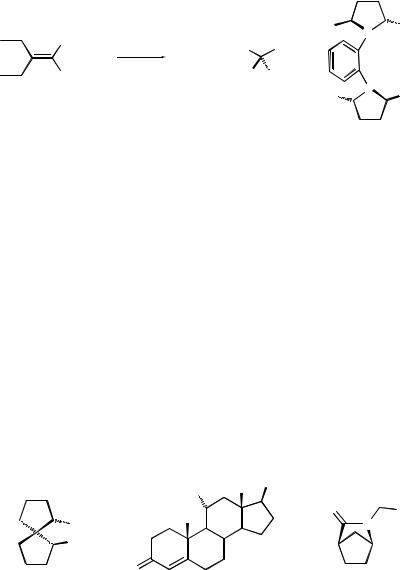
16 |
hydrolysis, oxidation and reduction |
dehydroamino acids. One of the more popular ligands for general usage has been Burk's DuPHOS (Scheme 13)*[63].
|
|
Me |
P |
Me |
CO2Me |
|
|
|
|
(CH3CH2)2CH |
CO2Me |
|
|
|
i |
|
|
||
NHCOMe |
MeCONH |
H |
|
|
|
|
Me |
P |
Me |
|
|
|
(S,S)- MeDuPHOS
Scheme 15: Reagents and conditions: i) Rh±DuPHOS (0.2 mol%), H2 (6 atm), benzene.
This strategy also gives access to a variety of non-natural a-amino acids. Furthermore, rhodium±DuPHOS complexes catalyse the asymmetric reduction
of enol esters of the type PhCH ˆ CH ÿ C(OCOCH3) ˆ CH2 to give (R)-2- acetoxy-4-phenylbut-3-ene (94 % ee)[64].
The use of chiral rhodium complexes fashioned from ferrocene derivatives has gained in popularity significantly in recent years*[65].
The portfolio of bisphosphine ligands for rhodium-catalysed asymmetric hydrogenation of dehydroamino acids is now becoming complemented by a set of bisphosphinite ligands*, typified by Chan's spirOP (16)[66] and carbohy- drate-based systems invented by Selke and RajanBabu[67]. The attraction of the use of the bisphosphinites lies in the simplicity of the preparation of the ligands (by reacting optically active diols with chlorophosphines in the presence of base)[68]. A remarkably selective one-pot procedure for sequential alkene and
carbonyl reduction using chiral rhodium and ruthenium catalysts allows the preparation of amino alcohols with up to 95 % ee*[69].
|
R |
Me |
COMe |
|
|
|
|
|
|
|
|
|
O |
Ph |
|
Me |
|
|
|
|
|
|
N |
|
|
OPPh2 |
|
|
|
|
OPPh2 |
|
|
|
|
O |
|
|
|
(16) |
(17) R = H |
|
(19) |
|
|
(18) R = OH |
|
|
|
the integration of biotransformations into catalyst |
17 |
1.3OXIDATIVE TRANSFORMATIONS
In this important area of synthetic chemistry honours are more equally shared between biocatalysis and other forms of catalysts, the latter being made up, almost invariably, of man-made organometallic species. Thus biotransformations are the preferred pathway for the hydroxylation of aliphatic, alicyclic, aromatic and heterocyclic compounds, particularly at positions remote from pre-existing functionality[70]. In contrast organometallic species are the catalysts of choice to convert alkenes into epoxides and diols. Both natural and non-natural catalysts are adept at the conversion of some sulfides into the corresponding sulfoxides and in performing stereoselective Baeyer±Villiger oxidations. Some of the details are provided hereunder.
The ability of microorganisms to convert alicyclic compounds into related alcohols by regioand stereo-controlled hydroxylation at positions distant from regioand stereo-directing functional groups was used extensively in the modification of steroids[71]. In a classical example the hydroxylation of progesterone (17) with Rhizopus sp. or Aspergillus sp. furnished the oxidized product (18), forming a key step in a highly efficient pathway to the anti-inflammatory steroids such as Betnovate[72]. Other complex alicyclic natural products and closely related compounds (e.g. taxanes)[73] have been selectively hydroxylated using some of the more easily handled organisms such as Mucor sp., Absidia sp. and Cunninghamella sp.
The selective monohydroxylation of heterocyclic compounds such as piperidine derivatives[74] and the g-lactam (19)[75] have been studied. It is also been
shown that hydroxylation of phenylcyclohexane can be effected using cytochrome P450 and the regioselectivity of hydroxylation can be altered by sitedirected mutagenesis of the enzyme[76].
While undoubtedly powerful methodology, the major problem concerning enzyme-catalysed hydroxylation of alicyclic and saturated heterocyclic compounds is the unpredictability of the site of hydroxylation. Not surprisingly a start has been made to control the regioselectivity of microbial hydroxylation by using an easily-introduced and easily-removed directing group which, if such a suitable auxiliary could be found, would very conveniently promote hydroxylation at a set distance from the temporary appendage[77].
The hydroxylation of aromatic compounds using microorganisms is more predictable and a number of processes have been adapted to large scale, for example the preparation of 6-hydroxynicotinic acid[78] and (R)-2-(4-hydroxy- phenoxy)propanoic acid[79], important intermediates to pesticides and herbicides respectively.
The biotransformation that has caught the imagination of many synthetic organic chemists involves the conversion of benzene and simple derivatives (toluene, chlorobenzene, etc.) into cyclohexadienediols (20) using a recombinant microorganism E. coli JM109. The one step oxidation, via reduction of the
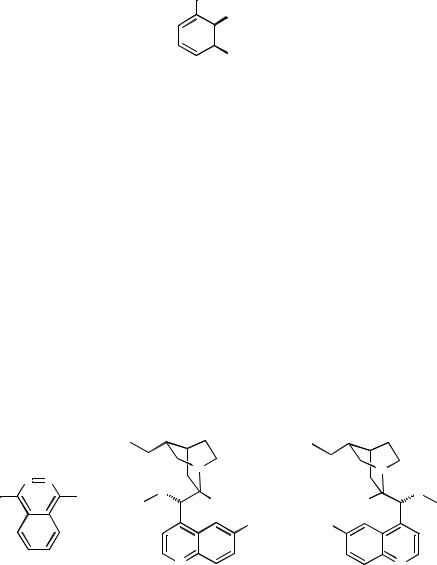
18 |
hydrolysis, oxidation and reduction |
R
OH
OH
R = H, Me, Cl
(20)
corresponding dioxetane, is impossible to emulate using any other simple process. Cyclohexa-3,5-diene-1,2-diol produced in this way was used as a starting material in the polymer industry. The dienediol products from toluene and chlorobenzene are even more interesting being essentially optically pure and, for this reason, they have been used to prepare optically active morphinans, carbohydrate analogues, pancratistatin and cis-chrysanthemic acid, generally by selective transformations involving the two alkene bonds[80].
However, for the dihydroxylation of alkenes the microbiological method is not so effective and the biocatalytic methodology pales into insignificance compared with the powerful chemical technique introduced by Sharpless.
Also fifteen years of painstaking work and the gradual improvement of the system, the Sharpless team announced that asymmetric dihydroxylation (AD) of nearly every type of alkene can be accomplished using osmium tetraoxide, a co-oxidant such as potassium ferricyanide, the crucial chiral ligand based on a dihydroquinidine (DHQD) (21) or dihydroquinine (DHQ) (22) and metha-
nesulfonamide to increase the rate of hydrolysis of intermediate osmate esters*[81].
|
|
N |
N |
|
N N |
|
(21) R = |
(22) R = |
|
R |
R |
O |
O |
|
H |
H |
|||
|
|
|||
|
|
OMe |
MeO |
|
PHAL |
|
N |
N |
|
|
|
|
||
|
|
(21) DHQD |
(22) DHQ |
A wide range of alkenes undergo the Sharpless AD reaction and the stereochemistry of the product diols can be predicted with a high degree of certainty, in most cases, through a simple mnemonic device (Figure 1.2). Thus the DHQD derivatives supplied with the oxidant have become known as AD-mix b while the DHQ derivatives (with oxidant) comprise AD-mix a[81]. Chosen from the
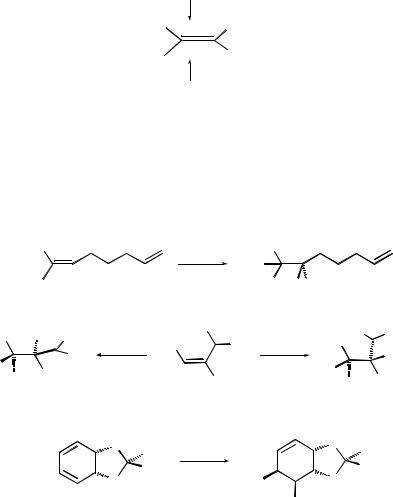
the integration of biotransformations into catalyst |
19 |
DHQD derivatives
b-face
RS RM
RL H
a-face
DHQ derivatives
Figure 1.2 Predictive model for dihydroxylation of alkenes.
very many reports in the literature[82] three examples are given in Scheme 16[83]. A modification of the dihydroxylation reaction allows for the aminohydroxylation of alkenes and this reaction is also assuming an important role in organic synthesis*[84].
|
Me |
|
i |
Me |
|
|
|
|
|
|
|
Me |
|
|
|
|
|
|
|
|
|
|
|
|
|
|
|
Me |
|
|
HO |
|
H OH |
|
|
|
|
|
|
|
|
94 % ee |
|
|
Me |
OH Me |
|
Me |
|
|
|
Me |
Me |
|
|
|
|
|
|
|||
Me |
Me |
|
|
Me |
|
|
||
|
i |
|
ii |
|
|
|||
|
|
|
|
OH |
||||
H |
Me |
|
|
|
|
|
|
|
CO2Et |
|
|
|
|
HO |
|
|
|
OH |
|
|
|
|
H CO2Et |
|||
|
CO2Et |
|
|
|
||||
|
|
|
|
|
|
|||
90 % ee |
|
|
|
|
|
85 % ee |
|
|
81 % yield |
|
|
|
|
|
|
||
|
|
|
|
|
83 % yield |
|||
|
|
|
|
|
|
|
||
|
O |
Ph |
ii |
|
|
O |
Ph |
|
|
|
|
|
|
|
|||
|
|
H |
|
|
|
O |
H |
|
|
O |
|
|
HO |
|
|
|
|
OH 99 % ee
85 % yield
Scheme 16: Reagents and conditions: i) AD-mix a, K3Fe(CN)6,MeSO2NH2, t-Bu OH, H2O ii) AD-mix b, K3Fe(CN)6, MeSO2NH2, t-BuOH, H2O.
The asymmetric dihydroxylation protocol was the second massive contribution by Professor Barry Sharpless to synthetic organic chemistry. The first procedure, introduced with Katsuki, involves the catalytic asymmetric epoxidation of allylic alcohols. A typical example is shown in Scheme 17, wherein (E)- allylic alcohol (23) is epoxidized with tert-butylhydroperoxide, in the presence of titanium tetra-isopropoxide and optically active diethyl tartrate to give the
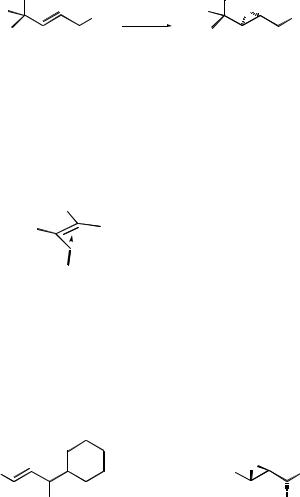
20 |
hydrolysis, oxidation and reduction |
epoxyalcohol (24)[85]. (Note, however, that the isomeric (Z)-alkene undergoes asymmetric epoxidation much less efficiently.) Such reactions are rendered catalytic by the addition of 4AÊ molecular sieves to adsorb adventitious water which otherwise attacks the key component, the titanium tartrate complex. The sense of asymmetric epoxidation of E-allylic primary alcohols is highly predictable*. The preferred products of the Katsuki±Sharpless oxidation are shown in Figure1.3. (Z)-Allylic alcoholsundergoless predictableoxidation, as mentioned above.
|
Me |
|
|
Me |
|
Me |
OH |
i |
Me |
O |
OH |
|
|
|
|||
Me |
|
|
Me |
|
|
|
(23) |
|
|
(24) |
|
|
|
|
|
95 % ee |
|
|
|
|
|
52 % yield |
|
Scheme 17: Reagents and conditions: i) Ti(O±i-Pr)4 (+)-diethyl tartrate, t-butylhydro- peroxide, ÿ208C.
(-)-dialkyl tartrate as ligand  R2
R2
R1 |
R3 |
|
Allylic alcohol as substrate |
 OH
OH
(+)-dialkyl tartrate as ligand
Figure 1.3 Oxidation of allylic alcohol using Ti(O ÿ i-Pr)4, TBHP and tartrate ligand.
Secondary allylic alcohols also undergo asymmetric epoxidation; in many cases, when the alcohol unit is attached to a stereogenic centre, kinetic resolution of the enantiomers takes place. This is particularly apparent for compounds of type (25), where the two enantiomers are epoxidized at rates which are different by two orders of magnitude[86].
Me3C |
Me3Si |
O |
C5H11 |
|
|||
OH |
|
|
OH |
(25) |
(26) |
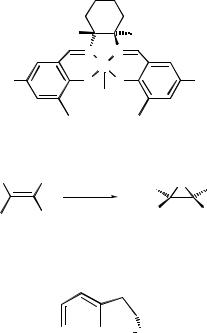
the integration of biotransformations into catalyst |
21 |
Similarly, racemic 1-trimethylsilyloct-(1E)-en-3-ol is epoxidized |
with |
Ti(O ÿ i-Pr)4 , t-butylhydroperoxide and (‡)-di-isopropyl tartrate at ÿ20 8C to give the epoxide (26) (> 99 % ee, 42 %) and recovered (R)-unsaturated alcohol[87].
In general, when using (‡)-tartrates, the (S)-enantiomer of the allylic alcohol will react faster.
The requirement for the presence of an adjacent alcohol group can be regarded as quite a severe limitation to the substrate range undergoing asymmetric epoxidation using the Katsuki±Sharpless method. To overcome this limitation new chiral metal complexes have been discovered which catalyse the epoxidation of nonfunctionalized alkenes. The work of Katsuki and Jacobsen in this area has been extremely important. Their development of chiral manganese
(III)±salen complexes for asymmetric epoxidation of unfunctionalized olefins* has been reviewed[88].
A typical manganese±salen complex (27)[89] is capable of catalysing the asymmetric epoxidation of (Z)-alkenes (Scheme 18) using sodium hypochlorite (NaOCl) as the principle oxidant. Cyclic alkenes and a, b-unsaturated esters* are also excellent starting materials; for example indene may be transformed into the corresponding epoxide (28) with good enantiomeric excess[90]. The epoxidation of such alkenes can be improved by the addition of ammonium acetate to the catalyst system[91].
|
H |
H |
|
|
|
N |
N |
|
|
|
|
Mn |
|
|
t-Bu |
O |
O |
|
t-Bu |
|
|
Cl |
|
|
|
t-Bu |
t-Bu |
|
|
|
|
(27) |
|
|
H |
H |
H |
O |
H |
|
i |
|||
|
|
|||
Ph |
Me |
Ph |
|
Me |
|
|
|
90 % ee
Scheme 18: Reagents and conditions: i) NaOCl, complex 27.





 O
O
(28)
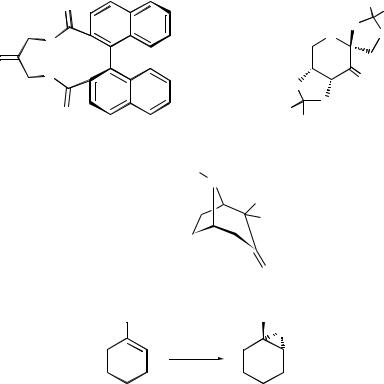
22 |
hydrolysis, oxidation and reduction |
The asymmetric epoxidation of E-alkenes and terminal alkenes proved to be more difficult, though a recent finding, describing the use of a modified salen complex to epoxidize (E)-b-methylstyrene to form the corresponding epoxide in 83 % ee, represents another important step forward. Alternatively, chiral (D2-symmetric) porphyrins have been used, in conjunction with ruthenium* or iron, for efficient asymmetric oxidation of transand terminal alkenes[92].
The epoxidation of nonfunctionalized alkenes may also be effected by chiral dioxiranes*. These species, formed in situ using the appropriate ketone and potassium caroate (Oxone), can be formed from C-2 symmetric chiral ketones (29)[93], functionalized carbohydrates (30)[94] or alkaloid derivatives (31)[95]. One example from the laboratories of Shi and co-workers is given in Scheme 19.
O |
|
|
Me |
Me |
|
|
|
||
|
|
|
|
|
|
|
|
O |
O |
O |
|
O |
|
|
|
|
|
||
|
|
|
|
|
O |
|
|
|
|
O |
O |
|
O |
|
|
|
|
||
|
|
|
|
|
|
Me |
O |
|
|
O |
|
|
|
|
|
Me |
|
|
|
(29) |
|
(30) |
|
|
EtO2C
N
F
H
(31) O
Ph |
Ph |


 O
O
i
Scheme 19: Reagents and conditions: i) Oxone, NaHCO3 , CH3 CN, ketone (30) (30 mole %), ÿ10 8C.
Historically, the asymmetric synthesis of epoxides derived from electronpoor alkenes, for example a, b-unsaturated ketones, has not received as much attention as the equivalent reaction for electron-rich alkenes (vide supra). However, a recent flurry of research activity in this area has uncovered several
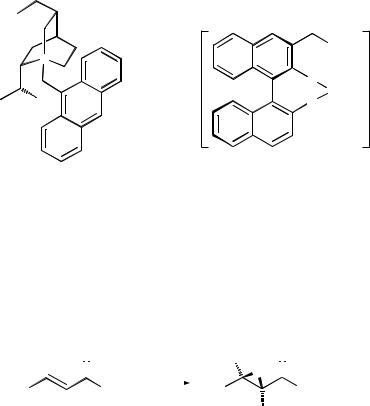
the integration of biotransformations into catalyst |
23 |
new methods. For example, Enders has shown that oxygen in the presence of diethylzinc and N-methyl ephedrine converts enones into epoxides in excellent yields and very good enantiomeric excesses* (up to 92 %)[96]. Alternatively, Jackson et al. have reported the employment of tert-butyl hydroperoxide as the oxidant together with catalytic amounts of dibutyl magnesium and diethyl tartrate. Chalcones are oxidized to the corresponding epoxides under these conditions in yields varying between 40±60 % and good to excellent enantiomeric excess[97].
For a similar series of chalcone derivatives the use of aqueous sodium hypochlorite in a two phase system (with toluene as the organic solvent) and the quinine derivative (32) as a chiral phase-transfer catalyst, produces epoxides with very good enantiomeric excesses and yields[98].
|
|
OH |
|
N+ |
|
|
|
O |
a-naphthyl |
OBn |
LaOiPr |
O |
n
(32) |
(33) |
However, the two methods of choice for the oxidations of a, b-unsaturated ketones are based on lanthanoid±BINOL complexes* or a biomimetic process based on the use of polyamino acids as catalysts for the oxidation*[99].
In the first of these techniques the lanthanoid complex (33) (5±8 mol%) is used as the organometallic activator in cumene hydroperoxide or tert-butyl
hydrogen peroxide-mediated oxidation of chalcone (epoxide yield 99 %; 99 % ee)* or the ketone (34) (Scheme 20)[100].
|
O |
H |
|
O |
|
|||
|
|
|
|
i |
iPr |
O |
|
|
iPr |
|
|
|
|
|
|
Ph |
|
|
|
Ph |
|
|
||||
|
|
|
|
|
|
H |
||
|
(34) |
|
|
|
|
94 % ee |
||
|
|
|
|
|
|
|||
|
|
|
|
|
|
95 % yield |
||
Ê
Scheme 20: Reagents and conditions: i) cumene hydrogen peroxide, 4A molecular sieve, THF, complex (33).

24 |
hydrolysis, oxidation and reduction |
The biomimetic protocol was invented by Julia and Colonna, and involves the use of polyamino acids (such as poly-(l)-leucine) as the catalysts for peroxide oxidation of chalcones, styryl alkyl ketones and conjugated alkenones. The substrate range is broad, especially when using immobilized catalysts and an
organic solvent containing the substrate, urea±hydrogen peroxide and an organic base (Scheme 22)[101].
|
O |
|
O |
|
i |
|
O |
Ph |
Ph |
Ph |
Ph |
|
|
|
>95 % ee |
|
|
|
>95 % yield |
Scheme 22: Reagents and conditions: i) poly-L-leucine, urea±hydrogen peroxide, THF, diazabicycloundecene.
Neither biocatalysts nor non-natural catalysts have yet been found that provide a robust method of choice for stereocontrolled conversion of a ketone
to an ester (or lactone) via a Baeyer±Villiger reaction. Thus whole cell biocatalysts can be used for very elegant transformations (Scheme 23)[102] but the
microorganisms (such as Acinetobacter sp.) need to be grown and harvested before use (an anathema to most organic chemists, particularly for organisms which are potentially pathogenic) and the use of the relevant isolated enzymes (Baeyer±Villiger monooxygenases) is plagued with the problem of cofactor
(NADH or NADPH) recycling and, often, progressive poisoning of the catalytic action of the enzyme by the product as it is formed[103]. The cloning of
useful Baeyer±Villiger monooxygenases into bakers' yeast may give, in time, more widely-available, easily-used microorganisms[104].
O
|
|
O |
|
|
O |
|
O |
O |
|
ii |
i |
|
H |
H |
Cl |
Cl |
Cl |
|
(R)-lactone |
(S)-lactone |
|
>99 % ee |
85 % ee |
Scheme 23: Reactions and conditions: i) Acinetobacter calcoaceticus, H2O ii) Cunninghamella echinulata, H2O.
3-Phenylcyclobutanone has been a substrate for a copper-catalysed Baeyer± Villiger oxidation. Thus the complex (35), (ca 1 mole%) in conjunction with
